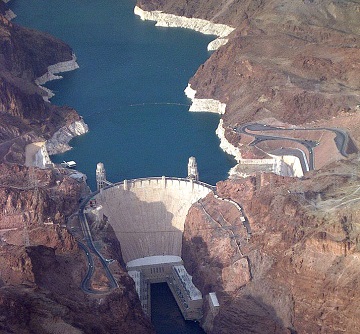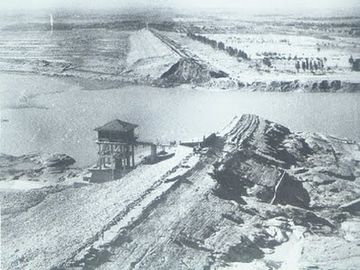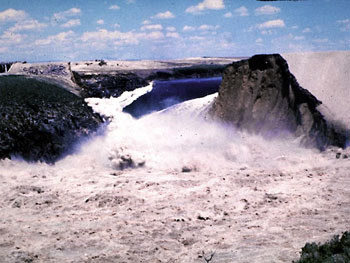Dam failures

A dam failure is simply an uncontrolled release of water from a reservoir through a dam as a result of structural failures or deficiencies in the dam.[2] Dam failures can range from fairly minor to catastrophic, and can possibly harm human life and property downstream from the failure.
Dam failures can be extremely harmful, especially because dams are considered "installations containing dangerous forces" under International Humanitarian law.[3] This is because of the immense destruction that can occur with a dam breach. Throughout history, a large number of dam failures have caused immense property damage when floodwaters destroy infrastructure. In addition, ecosystems and habitats are destroyed as a result of waters flooding them. Along with this, dam failures over the years have taken thousands of lives. The older that dams get, the more potential exists for catastrophic dam failures.[4]
Causes
There are four major causes of dam failures, they include:[2]
- Overtopping: These failures occur as a result of poor spillway design, leading to a reservoir filling too high with water, especially in times of heavy rainfall.[5] Other causes of this type of failure include settling of the crest of the dam or spillway blockage.
- Foundation defects: These failures occur as a result of settling in the foundation of the dam, instability of slopes surrounding the dam, uplift pressures, and seepage around the foundation. All of these failures result in structural instability and potential dam failure.
- Piping and seepage failures: These failures occur as a result of internal erosion caused by seepage and erosion along hydraulic structures such as the spillways. As well, erosion as a result of animal burrows and cracks in the dam structure contribute to these failures.
- Conduit and valve failure: These failures occur as a result of problems with values and conduits.
Other dam failures arise as a result of other miscellaneous causes. Many dam failures are also secondary results of other natural disasters such as earthquakes, landslides, extreme storms, or heavy snow-melt. Other causes include equipment malfunction, structural damage, and sabotage.[2]
Notable Failures
Worldwide there have been many dam failures, resulting in varying severity of damage—from destructing properties to deaths. The list of examples below is not comprehensive but rather serves as an indicator of how dams can fail and how these failures can cause damage.
Banqiao Dam

The Banqiao Reservoir Dam (along with 63 other dams) in the Henan province of China failed in 1975, killing an estimated 171 000 people (although some reports suggest the number could be as high as 230 000). When the dam failed, it destroyed the homes millions of people and is considered the largest dam failure in history.[7]
In August 1975, the region experienced an extreme flood, resulting in quantities of water falling that had not been considered during the construction of the dam. More than a year's worth of rain fell in only 24 hours, and the dam failed on August 8. Early on August 8, the dam was breached and 700 million cubic meters of floodwater was released, flooding communities and homes downstream. After this burst, a chain reaction began and the other 61 reservoirs located in the area collapsed—releasing another six billion cubic meters of floodwater. The water covered an area equal to 10 000 square kilometers. The failure to plan and account for extreme floodwaters resulted in the immediate death of 26 000 as a result of the water itself. 145 000 more people died as a result of epidemics and famine following the flood.[8]
Sayano–Shushenskaya Dam
A turbine in the Sayano–Shushenskaya dam in Khakassia, Russia broke apart violently on August 17, 2009, causing significant damage. The turbine hall and engine room flooded, destroying 9 of the 10 turbines and collapsing the ceiling of the turbine hall. A total of 75 people were killed. This led to significant power failures in the local area.[9]
The cause of the incident was reported to be unsafe vibrations coming from one of the turbines, which caused the turbine to break apart violently. Water that had been entering the turbine, flooded the turbine hall—flooding the room and levels below. The ceiling of the hall also broke apart from the impact from the turbine. At this point, power failed in the power station resulting in a blackout. Steel gates to the water intake pipes of the turbines were manually closed and spillways were opened to prevent more damage.[9]
Teton Dam

The Tenton dam near Idaho Falls failed completely on June 5, 1976, releasing the contents of its reservoir. This failure began with a large leak near the right abutment of the dam.[11] The dam failed just as it was being completed and filled for the first time. After the first leak was noticed, a wet spot developed on the face of the dam from seepage coming in from the abutment rock. The material began to slough off and erosion continued on the embankment. The water escaping increased as the hole grew and attempts to fill the hole failed. The dam breached when the crest of the embankment fell and a wall of water surfed through. 40% of the dam embankment was lost, and the powerhouse was completely submerged in debris. It released nearly 400,000 cubic meters of water, then flooded farmland and towns downstream with the eventual loss of 14 lives, directly or indirectly, and with a cost estimated to be nearly $1 billion.[11]
For Further Reading
- Dam
- Reservoir
- Hydroelectricity
- Hydroelectric facility
- Or explore a random page
References
- ↑ Wikimedia Commons. (September 2, 2015). Hoover Dam [Online]. Available: https://upload.wikimedia.org/wikipedia/commons/d/d8/Hoover_Dam_Nevada_Luftaufnahme.jpg
- ↑ 2.0 2.1 2.2 City of Roseville. (September 2, 2015). Dam Failure [Online]. Available: https://www.roseville.ca.us/civicax/filebank/blobdload.aspx?blobid=19067
- ↑ ICRC. (September 2, 2015). Practice Relating to Rule 42. Works and Installations Containing Dangerous Forces [Online]. Available: https://www.icrc.org/customary-ihl/eng/docs/v2_rul_rule42
- ↑ Association of State Dam Safety Officials. (September 2, 2015). Dam Failures and Incidents [Online]. Available: http://www.damsafety.org/news/?p=412f29c8-3fd8-4529-b5c9-8d47364c1f3e
- ↑ E. Goodarzi, L. Teang Shui and M. Ziaei, "Dam overtopping risk using probabilistic concepts – Case study: The Meijaran Dam, Iran", Ain Shams Engineering Journal, vol. 4, no. 2, pp. 185-197, 2013.
- ↑ International Rivers. (September 2, 2015). Banqiao Dam [Online]. Available: http://www.internationalrivers.org/resources/the-forgotten-legacy-of-the-banqiao-dam-collapse-7821
- ↑ C. Cleveland and C. Morris, Handbook of energy, Volume II, Chronologies, top ten lists, and word clouds. Waltham, MA: Elsevier, 2014.
- ↑ Si, Y., 1998. The World’s most catastrophic dam failures. Qing (1998a), pp.25-38.
- ↑ 9.0 9.1 Engineering Failures. (September 2, 2015). Sayano–Shushenskaya Dam Failure [Online]. Available: http://engineeringfailures.org/?p=703#sthash.tzjhWLIW.dpuf
- ↑ Wikimedia Commons. (September 2, 2015), Teton Dam Failure [Online]. Available: https://upload.wikimedia.org/wikipedia/commons/2/29/Teton_Dam_failure.jpg
- ↑ 11.0 11.1 Arthur Gibbs Sylvester. (September 2, 2015). Teton Dam Failure [Online]. Available: http://www.geol.ucsb.edu/faculty/sylvester/Teton_Dam/welcome_dam.html

